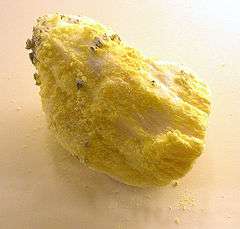Sassolite
| Sassolite | |
|---|---|
|
Yellow sassolite | |
| General | |
| Category | Borate mineral |
| Formula (repeating unit) | H3BO3 |
| Strunz classification | 6.AA.05 |
| Crystal system | Triclinic |
| Crystal class |
Pinacoidal (1) (same H-M symbol) |
| Space group | P1 |
| Unit cell |
a = 7.02 Å, b = 7.06 Å c = 6.59 Å; α = 103.65° β = 101.11°, γ = 59.98°; Z = 4 |
| Identification | |
| Colour | White to gray, may be pale yellow from included sulfur or pale brown from included iron oxides; colourless in transmitted light |
| Crystal habit | As scaly pseudohexagonal crystals; ncrustations; platy; tabular; may be stalactitic |
| Twinning | Around [001] as twin axis, common |
| Cleavage | Perfect on {001}, micaceous |
| Tenacity | Sectile |
| Mohs scale hardness | 1 |
| Lustre | Vitreous to pearly |
| Streak | White |
| Diaphaneity | Transparent |
| Specific gravity | 1.46-1.50 |
| Optical properties | Biaxial (-) |
| Refractive index | nα = 1.340 nβ = 1.456 nγ = 1.459 |
| Birefringence | δ = 0.119 |
| 2V angle | Measured: 5°, Calculated: 16° |
| Solubility | Soluble in water |
| References | [1][2][3] |
Sassolite is a borate mineral, and is the mineral form of boric acid. It occurs in volcanic fumaroles and hot springs, as well as in bedded sedimentary evaporite deposits.[1]
Its mineral form was first described in 1800, and was named after Sasso Pisano, Castelnuovo Val di Cecina, Pisa Province, Tuscany, Italy where it was found.[3] The mineral may be found in lagoons throughout Tuscany and Sasso.[2] Usually coloured white to gray, it is colourless in transmitted light, and can also take on a yellow colour from sulfur impurities, or brown from iron oxides.[1]
See also
References
External links
![]() Media related to Sassolite at Wikimedia Commons
Media related to Sassolite at Wikimedia Commons
This article is issued from Wikipedia - version of the 12/4/2016. The text is available under the Creative Commons Attribution/Share Alike but additional terms may apply for the media files.
